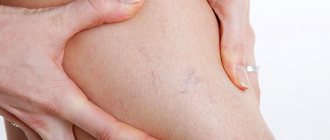Why does the vein in my leg burn?
It is difficult to answer the question why a vein in the leg burns if you do not know the person’s anamnesis (life history and illness). Therefore, before the doctor begins instrumental studies, he is sure to ask whether there were any prerequisites for the development of such a complaint as a burning vein in the leg.
The following may be considered prerequisites:
- Varicose veins in close relatives;
- Complaints of pain, heaviness and fatigue in the legs, which manifest themselves especially clearly in the evening and after static load;
- Green veins on legs;
- History of vein blockage;
- Spider veins on the skin of the legs.
If a person has the above symptoms, then it is highly likely that he suffers from varicose veins of the lower extremities. If there is a symptom such as a burning vein in the leg, the doctor may assume the development of complications of varicose veins: thrombophlebitis and deep vessel thrombosis.
These dangerous conditions develop when a blood clot forms in the lumen of blood vessels. The difference between them is where exactly the thrombus is localized: if in the superficial venous system it is thrombophlebitis, in the deep venous system it is thrombosis.
"Healthy vessels"
- Home /
- News /
- "Healthy vessels"
02.07.2020
Vascular diseases are common and dangerous pathologies that lead to disruptions in the functioning of various organs and systems, trophic lesions, severe consequences such as heart attacks and strokes, pulmonary embolism.
Doctors at the Yauza Clinical Hospital advise preventing such diseases. For this, our vascular surgeons have developed a special program for diagnosing preexisting conditions :
- swelling of the lower extremities;
- burning sensations in the legs;
- "restless legs" symptom;
- pain along the vein;
- seals in places of thrombosis;
- when the vein seems to be “burning”;
- hyperemia of the limb;
- "spider veins";
- shortness of breath;
- wheezing;
- feeling of lack of air;
- varicose veins;
- pain in the lower limb when walking (depending on the distance), subsiding during rest;
- constantly freezing feet.
PROGRAM STAGES:
1. Consultation with a specialist.
The initial consultation lasts on average 30 minutes. During this time, the doctor will conduct an examination, collect anamnestic data, and conduct physical and instrumental examinations. An ultrasound may be required, then the appointment will last 60 minutes. At the appointment, you can get a diagnosis or verify an existing one, that is, get a “second opinion”.
2. One or more instrumental studies.
- Triplex scanning of the veins of the lower extremities with functional tests The study allows you to evaluate the veins of the lower extremities in real time - the geometry of the veins, their patency, determine the presence of thrombosis and occlusions, identify varicose veins, developmental anomalies, valvular insufficiency
- Triplex scanning of the arteries of the lower extremities The study is absolutely painless, safe and has no contraindications. During the study, the doctor will determine the patency of the arterial bed, the presence of blood clots and atherosclerotic plaques.
As a result of the program, you will receive recommendations or the necessary treatment. Treatment is carried out in a hospital; the patient does not need to go anywhere else or look for a doctor on his own for a particular problem. The hospital adheres to the principle of personalized medicine. Doctors guide him from diagnosis to the final result and interact with each other.
Cost of services:
| Service code | Name of service | Price without discount, rub. | Discount | Discount price, rub. |
| B01.043.001 | Primary appointment (examination, consultation) with a cardiovascular surgeon | 3 900 | 100% | 0 |
| A04.12.015.003 | Triplex scanning of the arteries of the lower extremities | 5 400 | 20% | 4 320 |
| A04.12.015.002 | Triplex scanning of the veins of the lower extremities with functional tests | 5 400 | 20% | 4 320 |
The discount within the promotion applies only to the range of services. Services are paid separately in accordance with the price list on the day of their provision.
The appointment is conducted by a phlebologist, cardiovascular surgeon Rakhimov Amriddin Ravshanovich
Promotion period : 06/27/2020 – 09/30/2020
All news
Who should you turn to when a vein in your leg burns?
Thrombophlebitis and deep vein thrombosis require immediate medical attention. Moreover, the sooner qualified assistance is provided, the higher the chance that only conservative therapy will be required. Therefore, if you feel that a vein in your leg is burning and in addition to this, the symptoms described below appear, then immediately consult a phlebologist.
- Redness of the leg, especially pronounced along the location of the vessel;
- Local increase in skin temperature of the leg;
- Sharp or nagging pain in the leg that prevents you from walking independently;
- Severe swelling of the leg.
Angiologists and phlebologists use blood-thinning drugs—anticoagulants and antiplatelet agents—to treat these complications of varicose veins.
Reasons for rejection
Very thin blood vessels in the arms and lower extremities, which are virtually invisible, disappear due to such factors:
- passive lifestyle,
- lack of physical activity,
- freezing of the body and sharp constriction of blood vessels,
- poor blood circulation,
- individual characteristics of the body,
- age-related changes,
- low muscle mass,
- nervous tension.
Blue veins on the legs and arms often indicate vasodilatation and increased blood flow. Only appropriate diagnostics from a specialist will help to establish the exact causes of the disappearance of veins.
Often, veins disappear before injections, which is associated with stress on the body. After some time they become visible again. Thin veins in the legs and arms can be this way due to the physiological characteristics of the body. Treatment related to hiding blood vessels is prescribed by a doctor as needed. If they appear as a result of physical activity, this is a signal that you need to lead a more active lifestyle, strengthen blood vessels and improve blood circulation. Perhaps when the veins disappear, there is no need to do anything. There are unqualified personnel who cannot find them, but at the same time everything is fine with the person.
A vein burning in the leg: is it dangerous?
In order to determine why the vessel on the leg is burning, a phlebologist needs additional examination. The doctor, after performing Dopplerography of the vessels of the legs (it allows you to evaluate blood flow), confirms or rejects the diagnosis of thrombophlebitis and thrombosis.
If there is a thrombus in the lumen of the vessel, it will be visible on the monitor screen. It is important to determine the exact location of the thrombus. The risk of a blood clot breaking off from the vessel wall and blocking one of the vessels depends on this.
When a blood clot enters the pulmonary artery, pulmonary embolism develops. PE is a potentially life-threatening condition, since when blood circulation in the lungs is blocked, the entire body experiences oxygen starvation.
Treatment: what to do if the veins in your arms disappear
The condition of the circulatory system can be improved using preventive methods. It is important to exercise regularly, lead an active lifestyle and eat right. It is better to exclude alcohol and nicotine. Synthetic drugs are prescribed only after appropriate diagnosis and determination of the disease. Vasodilator medications are prescribed if necessary. In the case where the veins have disappeared during the installation of a catheter, blood sampling or injection, the limb is bandaged with a rubber tourniquet, above the point where the needle enters. If the doctor determines that the cause of such a feature is a disturbance in the functioning of the cardiovascular system, it is important to begin treatment of the factors that provoked such a deviation. Self-medication with folk remedies can cause irreparable harm to human health.
How to avoid conditions when a vein in the leg burns?
In order to avoid the sensation of a burning vein, you should follow the prevention of varicose veins of the lower extremities, which includes an active lifestyle, giving up bad habits and regular visits to a phlebologist. This is especially important for people at risk:
- For patients in the postoperative period (no matter what kind of operation was performed), it is not necessary to remain in bed for a long time. As soon as your doctor says you can walk, be sure to move. Immobilization leads to poor circulation and increases the risk of developing a blood clot in the veins.
- According to statistics, a huge number of women experience venous thrombosis and even thromboembolism during pregnancy. Pregnant women are advised to walk a lot in the fresh air, eat right and watch the kilograms they gain. It is advisable that your weight during pregnancy does not increase by more than 12 kg.
Do not ignore the appearance of pain and other symptoms of varicose veins. If treatment is started in a timely manner, thrombophlebitis and deep vein thrombosis do not occur.
Doctors told how to keep veins healthy
Cardiovascular surgeon, State Autonomous Institution "City Clinical Hospital named after. N.I. Pirogov” Evgeniy Dronov told how to keep veins healthy and what methods are used to treat varicose veins today.
Blood vessel diseases are very common. According to academician V.S. Savelyev, in the Russian Federation, about 35-38 million people suffer from various forms of varicose veins. The science that studies venous diseases is called phlebology.
In order to correctly diagnose and begin the necessary treatment, a series of examinations and consultations with various specialists is needed. For example, pain in the legs can be caused by diseases of the joints, and of a neurological nature, and, of course, can be associated with diseases of the blood vessels.
To diagnose vascular diseases, it is important for the patient to undergo an ultrasound examination of blood vessels, which makes it possible to examine the vessels from the inside, confirm or refute the presence of blood clots or atherosclerotic plaques, and measure the speed of blood flow.
Three main methods are used in the treatment of patients with varicose veins:
- First of all, this is surgical surgery as the main method of treating varicose veins. An operation is performed in which varicose veins are removed through incisions in the skin.
- Conservative therapy, as a more gentle method, includes normalization of motor activity, physical therapy, the use of elastic compression and treatment with phlebotonics. However, it cannot lead to complete cure and restoration of already dilated veins, so this technique is used as a prophylactic agent during preparation for surgery or when surgical treatment of varicose veins is impossible.
- Compression sclerotherapy is a treatment method in which a special drug is injected into an enlarged vein. The procedure allows you to get rid of spider veins and spider veins on the legs, is performed on an outpatient basis and is the least traumatic method of treating varicose veins, which does not require anesthesia, with a good aesthetic result.
Another modern and effective type of treatment for varicose veins is endovenous laser coagulation (EVLC). It is also performed on an outpatient basis, under local anesthesia. All stages are controlled in real time using an ultrasonic device. A light guide is inserted into the vein through a puncture. The vein is “sealed” using a laser. The patient is then put on a compression stocking to hold the vein in this condition.
GAUZ "GKB im. N.I. Pirogov" Orenburg is one of the leading medical institutions in the city and region providing medical care to patients with diseases of the veins and arteries. Doctors have effective methods for diagnosing and treating blood vessel diseases, allowing them to get rid of unpleasant symptoms and avoid serious complications. Since February 2020, the hospital has launched the “Healthy Veins” project, within the framework of which an angiosurgeon is seen and ultrasound duplex angioscanning of the veins of the lower extremities is performed. Reception of patients is organized according to a convenient work schedule - on Sundays of the week, when you can simultaneously undergo an ultrasound examination of the veins and immediately receive a consultation with an angiosurgeon based on the results of the ultrasound examination.
GAUZ "GKB im. N. I. Pirogov"
Paid medical services are provided in accordance with the “Regulations on the procedure for providing paid services to the population” on the basis of a license to carry out medical activities. Inquiries by phone: 44-03-03.
As an advertisement









